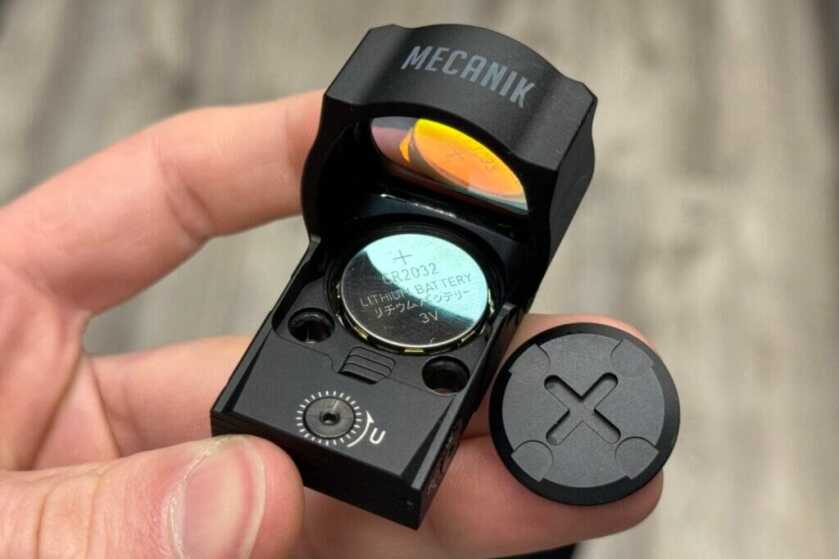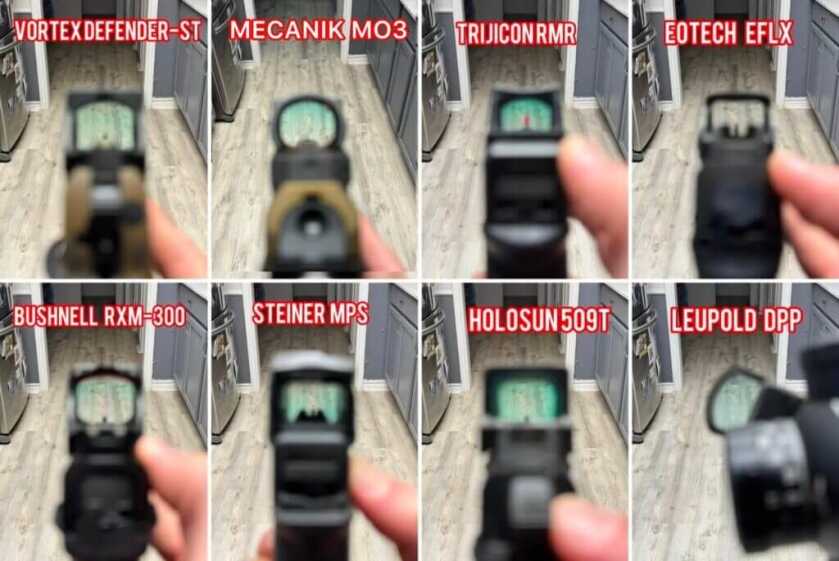
Estimated reading time: 8 minutes
Canik unveiled their new MO3 red dot at SHOT Show 2024. This optic boasts a 6 MOA reticle and a larger viewing window than most currently available options. The Tactical Concave Face enables easy single-handed pistol manipulation. The MECANIK MO3 boasts a battery life of up to 60,000 hours, motion activation, an automatic shutoff feature, and 10 brightness settings.
Table of contents
MECANIK® MO3 Specifications:
- Dot Size: 6 MOA
- Battery Type: CR2032
- Battery Life: Up to 60,000 hours
- Brightness Settings: 10 (2 night + 8 daylight)
- Eye Relief: Unlimited
- Magnification: 1x
- Adjustment: 1 MOA (100 MOA Windage & Elevation)
- Footprint: Trijicon RMR
- Parallax Setting: Parallax Free
- Size: 2.12×1.33×1.33″
- Weight (with battery): 1.62 oz
- Durability: IPX7 Waterproof rating
Housing
The MECANIK MO3 is crafted from 6061-T6 aluminum and boasts an IPX7 waterproof rating. With its recessed lens, this optic allows for slide manipulation by punching into objects if necessary, a technique I’ve used without experiencing any loss of zero or issues. While the conventional method involves using your offhand to rack the slide, having an optic that can withstand rough handling and aid in one-handed manipulations proves beneficial.
SEE MORE: 9mm Canik TP9 SFx Rival Grey Full Review

This red dot also adopts the Trijicon RMR footprint, ensuring compatibility with a wide array of mounts and factory slide cuts. Throughout my review, I mounted the MO3 onto the Canik TTI Combat, which came equipped with an RMR plate, resulting in seamless functionality. However, one drawback of this housing is its relatively thick base, causing it to sit high on most pistol slide cuts and potentially hindering compatibility with backup iron sights. Despite the Canik TTI Combat’s tall iron sights, the rear sight still remains below the top of the housing.
Battery
The MECANIK MO3 operates using a single CR2032 battery, conveniently loaded from the top. Canik claims that at the lowest brightness setting, the battery can last up to 60,000 hours. While higher brightness settings will reduce the runtime, the combination of an auto-shutoff feature and motion activation ensures impressive longevity.

Buttons
Brightness controls for the MO3 are located on both the left and right sides of the housing. The up arrow increases the dot brightness, while the down arrow decreases it. Despite their small size, both rubber buttons are tactile and easy to locate and operate. Additionally, the adjustments offer both tactile and audible feedback.

This red dot offers a total of 10 brightness settings, including 8 for daylight conditions and 2 for use with night vision. The maximum brightness setting appears to be on par with that of the Trijicon RMR, and the lowest settings are suitable for use under night vision.
Turrets
For zero adjustments on this optic, Canik utilizes an elevation turret situated on the top of the housing and a windage turret positioned on the right side. Adjusting the bullet’s point of impact is a matter of twisting these turrets accordingly. For instance, if the initial impact is high and to the right, adjustments are made by dialing down and to the left. Each click on the turrets corresponds to a 1 MOA movement in the bullet’s point of impact, meaning it takes 10 clicks at 10 yards to shift the point of impact by one inch.

The adjustments provide audible feedback, but the tactile feedback is minimal. There’s noticeable “mush” between clicks, and the turret doesn’t lock into place, potentially leading to unintentional sub-MOA adjustments. However, the low-profile turrets mitigate the risk of accidental adjustments. Yet these require the use of an Allen wrench to make adjustments which isn’t preferred due to needing a specific tool to make adjustments out in the field. Most red dots allow for adjustment using a flathead screwdriver or even just a piece of brass.
Glass
The window of the MECANIK MO3 is especially large. While the Trijicon SRO is recognized for its sizeable window of .98 x .89″, the MO3 surpasses it with an even larger window measuring 1.14×0.94″. This larger window is particularly advantageous for range and competition use, offering an expanded field of view and facilitating quicker and easier dot acquisition during drawing or shooting on the move.

Moreover, minimal distortion is observed when viewing from side to side. Compared to a wide range of red dots on the market, the glass is clearer than most. While many optics exhibit strong tints, the MO3 presents only a medium blue hue visible at the top of the window, gradually becoming clearer towards the bottom. I’ve included the image below to demonstrate its clarity compared to other optics. Please disregard the size differences in the image, as some optics appear closer than others. The emphasis of the picture is only to showcase clarity.
READ MORE: Beretta’s New 9mm, The APX A1 Comp Tac

Testing the MECANIK MO3
One aspect I wanted to assess with the MECANIK MO3 is its parallax performance. For a red dot to do its intended job, it needs to stay in the same spot despite where the dot is aimed. Some red dots exhibit significant point of impact shifts (up to a foot at 20 yards) when zeroed at the bottom of the window but then used at the top. However, the MO3 demonstrated excellent tracking capabilities. I mounted it on a tripod and aimed it at a bolt on my steel target 10 yards away, capturing pictures from various angles. Each picture depicted the dot consistently aiming at the same point, proving Canik’s “parallax-free” claim.

Durability
Machined from 6061 T6 aluminum, the MO3 housing looks and feels rugged. As noted earlier, the recessed glass design shields it from damage when forcefully engaging objects to rack the slide. Canik grants the M03 red dot an IPX7 rating, indicating its ability to withstand submersion in up to 1 meter of water for 30 minutes. Throughout my testing and firing hundreds of 9mm rounds while mounted on the Canik TTI Combat, this optic maintained its zero and functioned flawlessly.

The clarity of the glass enhanced target focus, while the spacious window provided a clear field of view. I encountered no difficulties achieving a rapid sight picture during draws and transitions. Additionally, the sharp 6-MOA dot allowed for accurate shooting up to 100 yards when mounted on a pistol. Although I typically favor a 3-MOA dot for pistols, the 6-MOA variant has proven to be remarkably precise and effective.
MECANIK MO3 Summary
With an MSRP of $250 and a street price below $200, Canik’s MECHANIK M03 red dot emerges as a compelling choice. It looks to be currently sold out everywhere so there may be a bit of a backlog, but I anticipate that to clear up shortly. While it may be a little on the large side for concealed carry, it is an excellent competition and range option. Boasting a common RMR footprint, top-loading battery, and generous window size, the MO3 performed admirably during my testing. In my opinion, it delivers commendable mid-range performance at an entry-level price point.
*** Buy and Sell on GunsAmerica! ***












Sounds pretty good so far but I’d have to see it survive some torture tests before buying.
They need a slightly smaller version with an RMSc footprint for the Canik pistols using that footprint.